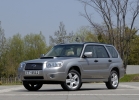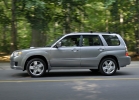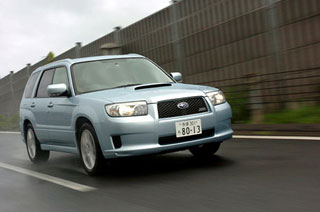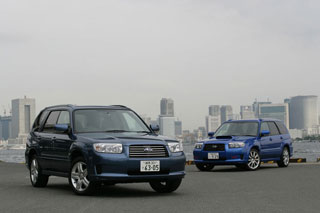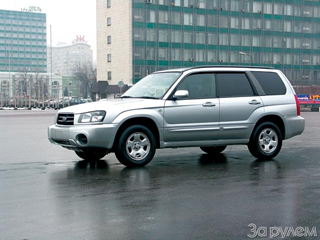Subaru Forester 2005 test drive - 2008 SUV
Tin Woodman
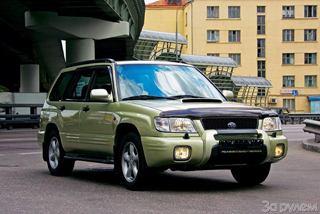 Forester, in our opinion, a forester, already in his name must be reliable and hardy, and even more so in the rich in forests of Russia. What is he in real life, Igor Kozlov will tell, and Konstantin Yakubov will show.
Forester, in our opinion, a forester, already in his name must be reliable and hardy, and even more so in the rich in forests of Russia. What is he in real life, Igor Kozlov will tell, and Konstantin Yakubov will show. Extraclassic element
The appearance of a foreman in 1997 (see the history of the model) caused disputes about its class belonging, which still do not subside. The proportions of the car, frankly, are unusual. It is high for the passenger station wagon, for an all -terrain vehicle is low, and for the SUV they are too flattened (the merit of a low opposite motor). However, no matter how you feel about the creation of Andreas Carpatinas chief designer, the forester of the forester turned out to be recognizable.
Body Sitty: During diagonal hanging, the door does not wedge, and the rust does not take it (unless, of course, the car has visited an accident). Crash tests for safety were carried out only by the American NHTSA. Five stars of seven possible for a car that goes through the roots in the last century can be considered a good result. Resistance to turning three out of five stars according to the same technique. We also conducted another curious experiment: they defeated the car according to the NRMA program, estimating the cost of recovery repairs after a light city clash (speed of 15 km/h, a hard barrier). Forester took a worthy third place cheaper in repair only other Subaru models. Be careful with body iron! American, European and Asian versions can be with different bumpers, radiator grilles and optics, and a car transitional period 20012002. With other wings and doors (in the USA, for example, the premieres of all forever took place a year earlier).
Two -headed opposition
There are a lot of engines for the forester, their power is from 122 to 265 hp. Two basic EJ20 and EJ25 (2,0 and 2.5 liters) can be with one or two camshafts in each head (there are two of the opponent), with or without turbocharged. In addition, variations with various peripherals, control blocks and boost pressure settings appeared annually, which is why only the main milestones of evolution are indicated in the history of the model. When repairing, it is important to know the decryption of the ponytail (after EJ20/25) so as not to run into the wrong parts, but such a hint is available only to specialists. We will not burden the features of the abbreviation, we only note that dealers have everything necessary for the repair of any motors (official and unofficial). In general, the engines are quite reliable, some serve without capital under 400 thousand km, but there are a number of operational features.
The main thing is to monitor the oil: to change in a timely manner (see the replacement regulations) and more often check the level, because its fumes are obviously larger in opponents. The norm is considered no more than 0.4 liters per 1000 km. Do not rely on the testimony of the lamp, it will light up when less than a liter remains in the crankcase! The consequences of oil starvation, of course, are deplorable to repair the cylinder-piston group ($ 15003800).
When buying a car without a service book, the first time we change the timing belt with rollers, even if the seller is afraid that he did it literally the day before. Vera word can turn into a serious repair with a replacement of bent valves, broken bushings and leaky pistons. In all engines, the belt replacement regulations are the same 105 thousand km. Along the way, we change the crankshaft and camshafts (given their low cost, you should not save). The pump, as a rule, is changed after (210 thousand km).
We recommend the candles relatives, iridium. Despite their considerable cost, they have a large resource (if you are lucky not to poison them with surrogate fuel, sometimes up to 60 thousand km!). The non -original, of course, is cheaper, but in equal conditions it does not live even half of this period, so that the money saved (or even more) will have to be spent on payment of unscheduled replacement work. It is not easy to crawl to the candles without a specification, especially on four-winging engines, where access to the horizontally deep candle wells located due to mudding and dense layout of the motor compartment (in the double-sized horizontally, the wells are smaller and look towards the tool slightly upward).
Follow the temperature regime! Often, plastic tanks of the engine radiator burst, losing antifreeze. True, mass gaps were marked only in Moscow (their peak came in 20022005), but residents of other regions should not relax a considerable part of the second-hand one from the capital. Deilers suggest that plastic loses its properties due to the effects of the capital's chemical reagents used by road workers in the winter. Fuji Heavy Industries does not have another explanation (read, Subaru), because the brand has no such sore in the world. But we can’t get ingenuity! Already in a semi -industrial way, aluminum tanks are produced in Russia, with which there is no such problem. Compared to the repair of an overheated engine, it is a converting of an inexpensive $ 730, while it is quite legal (even dealers recommend it).
ARTIFICIAL RESPIRATION
In engines with turbocharged, in addition, of course, more fuel consumption, there is another operational feature of it cannot be turned off immediately after a trip with high loads. If a turbotimer is not installed (or does not work), we definitely let the motor work on idle a couple of minutes to smoothly cool the turbine and thereby avoid hair sequeting in the axis bearings. However, just the Forester has extremely rare problems with turbocharged.
The Check Engine lamp is stewing the SSM-III dealer (Subaru Select Monitor). She can remind herself regardless of which motor works under the hood. Most often due to ignition passes (change candles, less often high-voltage wires) or interruptions in the supply of fuel (my nozzles). With another peripheral, problems are rare. On the Internet there are programs for portable computers and even mobile phones that allow you to correctly (programmatically) to extinguish the lamp without the participation of the OBD-II exchange dealer.
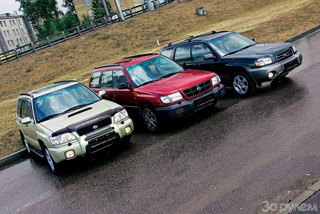 In the forest for firewood
In the forest for firewood Symmetric all -wheel drive of a highlight Subaru. In the standard operating modes of transmission problems, all troubles from revaluation of impassability opportunities. Sticky clay eats anthers (abrasive wear), in the deep rut, the rear suspension levers, the details of the exhaust system, and you never know what firewood can still be broken. For the conquest of serious off -road, Forester is not the best option. His elements are snow -covered city streets, a sag to the cottage and, of course, the satisfaction of the driver's ambitions. Sports genealogy of a good argument (the model is built on the units of Impreza, known for its achievements in motorsport).
For the drive, a mechanical gearbox is best suited, however, you will have to put up with a tight and long clutch pedal. But the manual transmission is attached to a good milking a demultiplier with a gear ratio of 1.45, even more expanding the possibilities for off -road (lever next to the handbrake). There are almost no problems with the mechanics, except for 150 thousand km, the clutch may require replacement. The drive for drive is not the best option: too thoughtful. In principle, the automatic transmission is tenacious, but there are exceptions.
Cars from America often come with a killed box. Either they do not know how to ride there, or they save in oil. Whether or not, the dealer is diagnosed before buying such a car, you should not guess! Repair of the unit can pull at $ 20003,000, turning saving on the overseas version into ruin.
However, diagnostics will not interfere with Europeans. Those may be with acidified calipers (floods there are not uncommon). Not only is the ride on such a car is unsafe, but the pads will instantly echo to zero. With normally working calipers, there are an average of 4050 thousand km (automatic transmission), and brake discs for two sets of pads.
The best options for buying a used foreman are the Russians who officially came to our market. It is no accident that they are more expensive by an average of 10%, because everyone has a transparent legal and technical past, because the demand for them is higher, and it, as you know, dictates the price. Models S10 19981999. You can find for $ 12,000, S11 20022003. They offer from $ 17,000, but the one -year -old sometimes go for $ 32,000! Expensive, but the goods are worth it.
The history of the model
1997 Frankfurt. Presentation of Subaru-Forester (SF body, model code S10). Body 5-door station wagon. OP4 gasoline engines: 2.0 liters, 90 kW/122 hp.; 2.0 l, 130 kW/177 hp (with turbocharged); 2.5 l, 118 kW/160 hp Symmetric drive is full, M5 or A4.
1998 OP4 gasoline engines: 2.0 l, 92 kW/125 hp.; 2.0 l, 184 kW/250 hp or 195 kW/265 hp (depending on the pressure of the boost); 2.5 l, 121 kW/165 hp.; 2.5 l, 155 kW/211 hp (with turbocharged).
1999. A gasoline engine with turbocharged OP4, 2.0 liters, 125 kW/170 hp
2000, light facies, bumpers, radiator grille, interior materials have changed.
2002 2nd generation Forester (SG body, model S11).
2004 Modification 2.5 kt, gasoline engine with turbocharged OP4,
2.5 l, 154 kW/210 hp
2005 Restyling. Stabilization system (Vehicle Dynamics Control) in the basic configuration. Changed: optics (xenon headlights), bumpers, interior (an enlarged rear seat pillow, additional hooks for securing goods). Gasoline engines: OP4,
2.5 l, 169 kW/230 hp (with turbocharged); OP4, 2.5 l, 130 kW/177 hp STI modification (only for the Japanese market): M6, Brembo brakes, wheel 18 inches.
The first place in the reliability rating (TU..V), the 3rd in a row victory in the competition of the year in the UK (The Caravan Club) and the 2nd in the USA (Car and Driver).
2006 Million Forester. Title of car of the year in Russia.
2007. The anniversary series (only white) with minor changes in the interior and nameplate on the body 10th Anniversary.
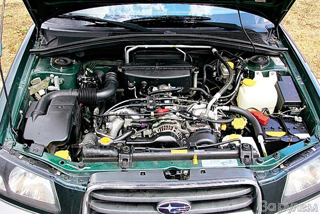
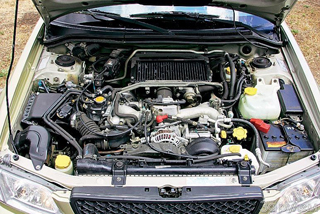
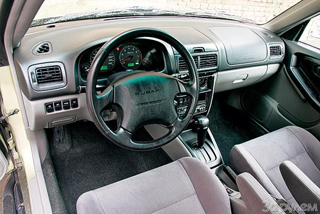
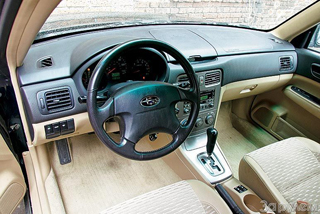
Source: The magazine "Driving"



